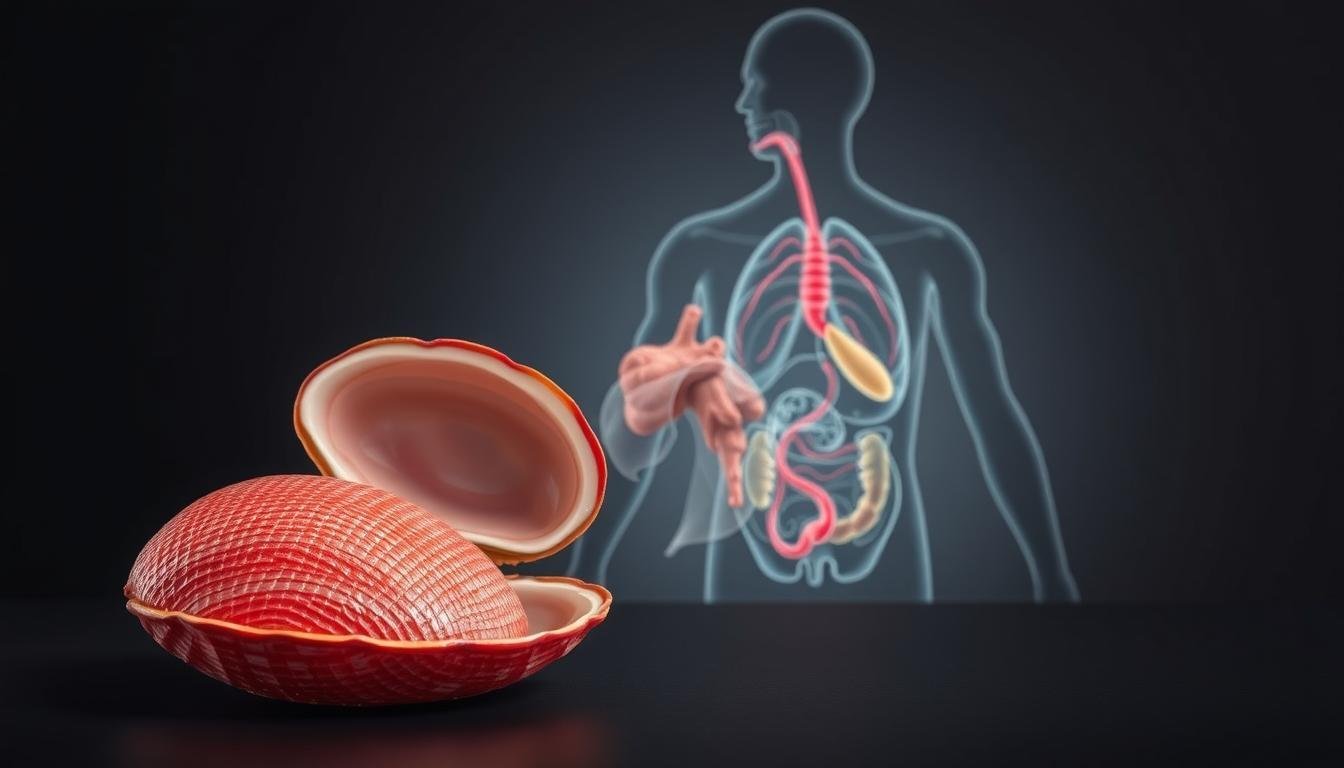Are Blood Clams Dangerous? Thinking about adding blood clams to your meals? It’s key to know the health risks they might bring. Like other shellfish, blood clams can be risky because of how they eat and where they live.
Eating contaminated blood clams can cause serious food poisoning. It’s important to know where these clams come from and how they’re caught.
Want to add blood clams to your diet? You’ll need to understand their safety and how to avoid health problems. This article will help you learn what to watch out for.
Contents
- 1 What Are Blood Clams?
- 2 Why Are Blood Clams Dangerous?
- 3 Health Risks Associated with Blood Clams
- 4 Recognizing Symptoms of Blood Clam Poisoning
- 5 Safe Handling and Preparation Practices
- 6 Regulations and Testing of Blood Clams
- 7 Safer Alternatives to Blood Clams
- 8 Blood Clam Safety: A Conclusion
- 9 FAQ: Are Blood Clams Dangerous?
- 9.1 What are the most common symptoms of blood clam poisoning?
- 9.2 Are there any regulations in place for monitoring blood clams?
- 9.3 Can cooking blood clams eliminate the risk of poisoning?
- 9.4 What are some safer alternatives to blood clams?
- 9.5 How can I identify if blood clams are safe to eat?
- 9.6 What should I do if I suspect I have blood clam poisoning?
What Are Blood Clams?
Blood clams, or Anadara spp., are a type of clam found worldwide. They have red or pink flesh because of hemoglobin. This makes them unique compared to other clams.
Blood clams live in both tropical and temperate waters. They like muddy or sandy bottoms, where they burrow to eat. They filter feed on phytoplankton and small organisms.
People in coastal areas often eat blood clams. But, eating them can be risky because of contamination and toxicity.
Knowing about blood clams helps us understand their value in food and the dangers they pose.
Why Are Blood Clams Dangerous?
Blood clams, a favorite seafood, can be risky under certain conditions. They are filter feeders that can pick up toxins and pathogens from the water. This makes them potentially harmful to eat.
The main worry with blood clams is the toxins they might hold. These include Vibrio vulnificus and Vibrio parahaemolyticus. These pathogens can lead to severe food poisoning. Symptoms can include vomiting, diarrhea, and stomach pain. In serious cases, they can be deadly, especially for those with weak immune systems.
- Contaminated water: Blood clams can soak up pollutants and pathogens from their surroundings.
- Inadequate cooking: If blood clams aren’t cooked right, the pathogens they carry can cause illness.
- Handling practices: Bad handling and storage can lead to cross-contamination, raising the risk of foodborne illness.
Knowing these risks is key for those who love blood clams. By understanding the dangers and taking steps to avoid them, you can enjoy this seafood safely.
Health Risks Associated with Blood Clams
Thinking about adding blood clams to your meals? It’s key to know the health risks they carry. Like other shellfish, blood clams can pick up toxins from their surroundings. These toxins can then harm humans who eat them.
These toxins can lead to various health problems. They can cause mild allergic reactions or even life-threatening conditions. The biggest dangers come from toxins that cause paralytic shellfish poisoning (PSP) and amnesic shellfish poisoning (ASP).
The Impact of Toxins on Human Health
The toxins in blood clams can severely affect human health. PSP can lead to numbness, paralysis, and even breathing failure in severe cases. ASP can cause memory loss, seizures, and other brain issues.
To stay safe, buy blood clams from trusted sources. Also, make sure to handle and cook them correctly. Knowing these risks and taking the right steps can help you decide if blood clams are safe for you.
Recognizing Symptoms of Blood Clam Poisoning
If you’ve eaten blood clams recently, you should know the signs of poisoning. Symptoms include nausea, vomiting, and diarrhea. In severe cases, you might feel numbness, tingling, or even paralysis.
If you’re feeling any of these symptoms after eating blood clams, get medical help right away.
| Symptom | Description |
|---|---|
| Nausea and Vomiting | Initial reactions to blood clam poisoning often involve gastrointestinal distress. |
| Diarrhea | A common symptom that can lead to dehydration if not managed properly. |
| Numbness or Tingling | Neurological symptoms that can occur in more severe cases of poisoning. |

Spotting these symptoms early can help a lot. If you’re not sure about your symptoms or have eaten blood clams, see a doctor.
Safe Handling and Preparation Practices
To avoid blood clam poisoning, follow safe handling steps. It’s key to store them right to keep them fresh and safe.
Put blood clams in a covered container. Let them breathe by keeping them moist with a damp cloth. Refrigerate them at a temperature below 40°F (4°C). Don’t use airtight containers or soak them in water.
When cooking blood clams, make sure they’re fully cooked. Throw away any open or cracked clams before cooking. Steaming is best as it keeps their flavor and texture.
Cook the clams until their shells open. This means they’re ready to eat.
| Preparation Method | Cooking Time | Tips |
|---|---|---|
| Steaming | 5-7 minutes | Ensure clams are covered and steam escapes. |
| Boiling | 3-5 minutes | Use saltwater and discard unopened clams. |
| Grilling | 2-3 minutes per side | Clams should open during grilling. |
By following these tips, you can safely enjoy blood clams. Always check local health advisories before eating them.
Regulations and Testing of Blood Clams
The safety of blood clams is checked regularly. In the United States, the FDA and local health departments watch over them. They make sure blood clams are safe to eat.
Rules for blood clams include checking the places where they are found. This is to keep them free from harmful things. Shellfish, like blood clams, have strict rules to avoid poisoning.
Testing blood clams looks for bad bacteria, viruses, and toxins. This is key to stop food poisoning from eating bad blood clams.
With these rules and tests, eating blood clams is much safer. This makes them a good choice for food lovers.
Safer Alternatives to Blood Clams
Seafood fans have plenty of tasty and safe options instead of blood clams. You can try other clams or shellfish that are less likely to have contaminants. For example, farmed clams and mussels are safer. They are raised in controlled places where they are watched closely.
Here is a comparison of some safer seafood options:
| Seafood | Risk Level | Nutritional Value |
|---|---|---|
| Farmed Clams | Low | High in Protein, Low in Fat |
| Mussels | Low | Rich in Omega-3 Fatty Acids |
| Oysters | Moderate | High in Zinc and Protein |
When picking seafood, always check local advisories. Look for certifications that show the seafood has been tested for contaminants. This way, you can enjoy your seafood favorites while keeping health risks low.
Blood Clam Safety: A Conclusion
It’s important to know the risks of blood clams for your safety. These clams can be dangerous because of contamination. Knowing the signs of poisoning and how to handle them safely is crucial.
Rules and tests help keep blood clams safe. Knowing about these steps and choosing safer options can reduce risks. By being careful and informed, you can enjoy blood clams safely.
In short, being careful with blood clams is essential for a safe meal. Stay informed, handle them with care, and always put your health first.
See Also: Why is Bessemer AL So Dangerous? Exploring the Risks
FAQ: Are Blood Clams Dangerous?
What are the most common symptoms of blood clam poisoning?
Symptoms include nausea, vomiting, and diarrhea. You might also feel abdominal pain. In severe cases, it can lead to paralysis or breathing problems.
Are there any regulations in place for monitoring blood clams?
Yes, there are rules and tests to check if blood clams are safe. They look for toxins and contaminants.
Can cooking blood clams eliminate the risk of poisoning?
Cooking can help reduce the risk, but it’s not a complete fix. Some toxins don’t get destroyed by heat.
What are some safer alternatives to blood clams?
Safer choices include other clams or mussels with less toxins. You can also try oysters, scallops, or shrimp. These are safe if sourced and handled right.
How can I identify if blood clams are safe to eat?
Look for blood clams from approved areas. Check if they are stored and handled correctly. Also, make sure they’ve been tested for toxins.
What should I do if I suspect I have blood clam poisoning?
If you think you have poisoning, get medical help right away. Quick treatment can help and prevent worse problems.

Lorenzo Sloan is a safety advocate from Los Angeles who exposes hidden and everyday dangers through research-based blogging. With a background in social work, he aims to keep readers informed, cautious, and prepared for the unexpected risks around them.

